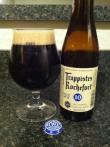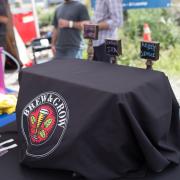Results from Tuesday Brewsday:
So after scouring the internet unsuccessfully for pratical applications of partigyle vis-a-vis extraction of grain, we decided to just do it ourselves.
As a note, due to the limitations in mashtun size, we were unable to do a "true" partigyle with 2 5.5 gallon batches. But whatever, in principle it all works out, and it's a good mathematical exercise in the efficiency of the process.
And hopefully this will de-mistify the aspects of efficiency that I hear people struggling with (either people coming in under gravity, and not knowing how to diagnose it, or people coming in at gravity, but way under volume, and saying "I hit my gravity!").
Note that there is some generous rounding in the exercise. As noted, if we assume that the rounding is normally distributed across all measurements (i.e. I sometimes go a little over, sometimes a little under), a lof these variance problems become less significant (certainly compared to the sample size of one we have here).
Our recipe:
Mash:
16 pounds 2 rows (37 ppg)
1.5 pound Munich 10 (33 ppg)
= 642 potential yield (maximum practical yield is somewhere around 95%) from mash
1 pound table sugar (46 ppg)
3 pounds Amber DME (42 ppg)
0.5 pounds maltodextrin (20 ppg)
= 192 yield from adjuncts
= 834 points maximum yield
Method:
Mash grains at 155 with mash thickness of 1.25 (this number doesn't actually matter that much, just get it to temp) for 60 minutes
After 60 minutes, perform a "mashout" buy adding 180 degree water until all headspace in the mashtun is filled.
Vorlauf, then drain the wort into Kettle 1. We collected about 6 gallons first runnings from this process.
Using 180 degree water, fill the mashtun again. Re-vorlauf.
Drain the second runnings into Kettle 1 until we get 8 gallons. This is our "big beer".
Gravity measurements of "Big Beer" was 1.055 points for 8.25 gallons of wort. This means we got an extract of 454 points for our "Big Beer".
The mashtun was still full at this point, so we drained the mashtun into Kettle 2.
Using 180 degree water, fill the mashtun again. Re-vorlauf.
Drain the third runnings into Kettle 2 until we get 8 gallons. This is our "Small Beer".
Gravity measurements for the "Small Beer" was 1.015 for 8.5 gallons of wort. The extraction, therefore, is 128 points for our "Small Beer".
Total extraction from grains from our Big Beer and Small Beer is 454 + 128 = 582 points out of a possible yield of 642. Our extraction is therefore about 91% (in practicality, the upper bound of extraction is about 95% due to dead space in the mash tun and the potential incidence of tannins in the wort).
So of the potential sugar extraction we calculated above, about 70% of it came out into the Big Beer, and about 21% in the Small Beer.
Afterwards, we added our adjuncts.
1 pound sugar to the Big Beer, and 3 pounds of amber DME and 0.5 pounds maltodextrin to the Small Beer.
Now we just go about our boil as normal for these 2 beers.
After chilling, the yields were:
4.75 gallons of Big Beer at a gravity of 1.09 (428 points)
5.5 gallons of Small Beer at a gravity of 1.052 (286 points)
As a note, about a quart of wort from the Big Beer made it into the Small Beer since we didn't flush the counterflow chiller in between chills. If you do the math here, you'll see that the Small Beer actually gained points between the kettle and fermenter. This is due to adding about quart of wort from the previous batch (about 23 points).
If we add this up, we get 714 brewhouse points of wort out of our theoretical maximum yield, which is about 86% total brewhouse efficiency.
If you are curious, you can even guesstimate a method for backing out the adjunct content of the beer.
Less table sugar, our Big Beer had a brewhouse efficiency of about 60%.
Less extract and maltodextrin (and including the chiller boo boo noted above), our Small Beer had a brewhouse efficiency of about 22%. This is the number I have noted on the whiteboard.
Note that we gain "efficiency" from the addition of DME since it is, for all intents and purposes, 100% extractable.
Pics or it didn't happen:
.jpg)









I'm exhausted from just reading that.
You took a fun hobby and turned it into math homework!
I kid, this is awesome! I'll never be the kind of brewer that actually applies this information to anything, but's fascinating to read. Just out of curiosity, what kind of hop schedule did you do?
Brock, we actually used 2 different hop schedules.
Our big beer is going to be a rich belgian Tripel. Expected abv is...excessive. Hop schedule was 2 ounces of Styrian goldings at first wort (although you could honestly use any noble hop, Saaz, Hallertau M, Tettnang, Spalt, even Fuggle or East Kent Goldings, or Mt Hood if you like to buy American), and pitched 2 packs of WY3787 high gravity abbey yeast.
The small beer is an American amber. Expected abv about 5%. 1 ounce of warrior at first wort, 1.5 ounce Citra at 5 minutes. I had wanted to use Columbus and Chinook but I left them at home. The warrior is definitely pretty old. Would say it clocks in at about 50 IBU. Pitched one pack SO5.
Awesome read, great job guys. Can't wait to try the beers
"Give a man a beer, and he will waste an hour. Teach a man to brew, and he will waste a lifetime!" Bill Owen